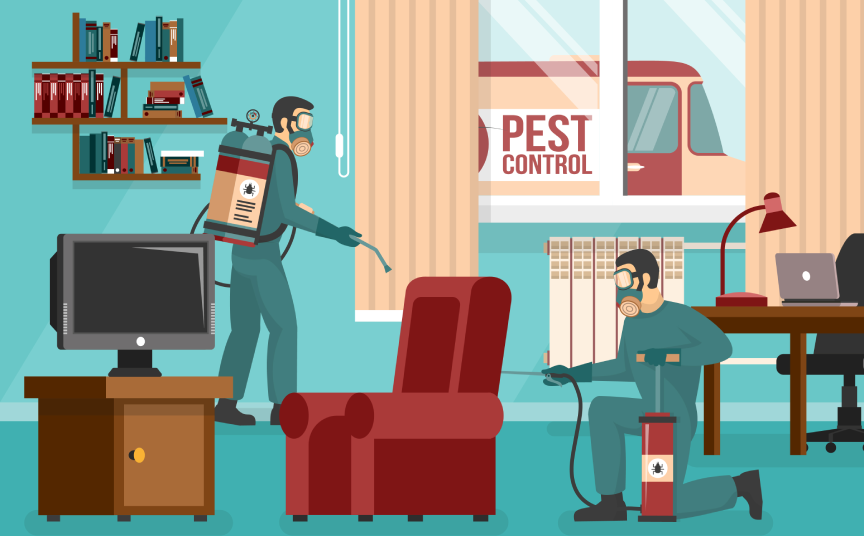Spire Pest Control
Termite Control
Free Inspections
Termite Control
Spire Pest Control’s Termite Exterminator Service
Each year, termites cause an estimated $5 billion in property damage. These tiny pests form in large colonies and can cause serious damage to your home. If you’re seeing them, you definitely need termite treatment right away. After all, you’ve invested a lot in your home. What will happen if it’s ruined by an infestation of tiny wood-eating bugs? There are many species of termites that could be invading your home, and it can be very difficult to remove them from your home. It’s best to get professional help. Contact the professionals atSpireand we’ll get to work on your termite control issue.
Signs of a Termite Infestation
You might already know you need a termite treatment, but here are the most common signs termite exterminators look for.
Mud Tubes /Mud Tunnels
Termites use these cylinder-shaped pathways to travel along exposed areas while foraging for food. These might look like branches of dried mud attached to the side of poles, house foundations, metal fences, and other places.
Swarmers
Swarmers are winged termites that a well-established colony produces once or twice every year. They can be easily mistaken for winged ants, but if you see swarmers in your home it’s a sure sign a colony is close by.
Discarded Wings
After their initial flight, the swarmers lose their wings. These can be found virtually anywhere, but they’re most commonly found near the nest.
Wood Damage
Since termites eat wood from the inside out, damage is difficult to detect. It might show as bubbling wallpaper or hollow and weakened wood.
Frass
Frass is termite droppings, which look like tiny wood grains or sawdust. They are sometimes found near a hole in the wood where the termites dump their droppings.
Things You Need to Know About Termites
- Termites are usually between ¼-inch to ½-inch long. Their antennas come straight out of their heads, and their bodies are soft. Termite coloration ranges from white to light brown in color.
- There are around 2,000 known termite species in the world. However there are a few that are common in the U.S. and pose the largest threat to homeowners:
- Dampwood termites: These termites infest wood with a high moisture content, hence the name. As long as your home is dry and sound, they will usually stay away.
- Drywood termites: Typically drywood termites live in warm climates, everywhere south of North Carolina, this invasive species does not require contact with soil. They will build nests in attics, roof materials, and in walls. Although they do not need as much moisture as other termites, drywood termites will usually build near water sources, such as leaky pipes in your walls.
- Formosan termites: Often referred to as “super termites”, Formosan termites are the most aggressive termite species and form massive underground colonies. They will chew through wood, flooring, and even wallpaper.
- Subterranean termites: These termites are found in every state in the continental United States and live in moist secluded areas in colonies of up to 2 million members. They are by far the most destructive termite species in the U.S.
- In each termite species, there are three different castes or classes. Castes are separated by duties and appearance. It takes a lot of work to run a termite colony!
- Workers: Worker termites collect food for the colony. They build and maintain structures like mud tubes and nests, meaning these are the termites that cause structural damage to your home. These generally look more like larvae.
- Soldiers: Soldier termites have the heavy responsibility of defending the nest. Ants pose the biggest threat to the colony, so termites go after ants more than other pests. While a soldier’s body looks similar to a worker’s, their heads and mandibles are bigger, making it easier for them to attack.
- Alates (Flying termites): Alates have the potential to be kings or queens of new termite colonies. They don’t actually cause damage, but seeing these winged termites is a sure sign you have a termite infestation. These flying termites have dark exoskeletons and two sets of long wings.
Helpful Termite Prevention Tips:
- Pile wood at least 20 feet away from the house
- Reduce moisture in and around the home
- Trim trees and bushes at least 1 foot away from the house and 2 feet away from each other
- Clean up wood and plant debris around the house
We Proudly Use Sentricon® to Eliminate Termites
The Sentricon® system is like no other termite treatment plan. It uses termites’ very nature — their constant foraging in search of food — against them. Worker termites find the bait in the Sentricon® stations while foraging, and share it with the queen and other colony members. Sentricon® stops the process of molting which ultimately affects the queen and reproduction and kills the workers. The colony then crumbles and is eliminated.
Installation
After a technician inspects your property, bait stations are placed around your home. Utilizing Always Active™ technology, the Recruit® HD bait is immediately available. In-ground stations have a visible service cover only opened by a special key.
Forging
Preferring the bait nearly 10 times more than wood, worker termites discover and quickly share their new “food” source within the colony. Noviflumuron is the active ingredient in Sentricon®. Noviflumuron prevents termites from maturing through molting.
Elimination
Unable to molt, termites die. And when the colony dies, the queen isn’t too far behind. Like a captain going down with the ship, despite her resolve to survive, there’s just no hope.
Protection
Imagine 24/7, worry-free protection now and well into the future. All it takes is your original bait stations and ongoing service from aSpire Pest Control technician. For what it’s worth, termites prefer you opt out of this offering.
Benefits:

No digging or trenching

No structural drilling

No need to treat the soil

No scheduling hassles
How Do I Get Rid Of Bed Bugs?
Step 1: Schedule
Call (888) 316-3615 for a free bed bug treatment quote and a timely appointment with skilled technicians. No obligation to proceed.
Step 2: Treatment
A certified technician will conduct a thorough bed bug inspection of your home to provide a customized treatment plan.
Step 3: Follow Up
We provide a detailed report of the service and helpful recommendations. For maximum effectiveness, receive a follow-up treatment 14 days after treatment.
Satisfaction Guaranteed!
We guarantee you won’t see bed bugs for 30 days. If you do, we will come back and treat again for free.
or to Schedule
Same Day* Service

Why Choose Spire Pest Control?
- Locally Managed & Operated
- Free Inspection & Estimate
- Same Day* Service
- Results 100% Guaranteed
- Fully Trained, Licensed & Insured Staff
Termite Control FAQ
Why do I need professional termite treatment?
Termite damage is not covered by home insurance, and treating termites on your own is a daunting and monumental task.
Spire Pest Control technicians have the tools and equipment necessary to perform thorough inspections and apply environmentally responsible products that will control the termites for good.
Are termite treatments complicated?
Professional termite exterminators train thoroughly to receive the proper certifications and approvals to perform termite treatment procedures.
Can I get rid of termites by myself?
It’s not a good idea to try to get rid of termites on your own. Non-professional efforts to get rid of termites easily waste time and money.
Termite exterminators require thorough training and experience beforeSpirewill send them to treat your home. Some termite treatments require drilling, digging, tens or even hundreds of gallons of termiticides and years of specialized training and experience.
What are the signs of termites?
- The most common signs of termites include:
- Termite excrement, which is called frass. This looks like tiny pellets of wood or sawdust.
- Mud tunnels, or mud tubes. Termites mix dirt with their saliva and create these tunnels to travel from one place to another without exposure to predators or the elements.
- Swarmers. These are winged termites that fly out of the nest, usually around spring but sometimes year-round. A mature termite queen produces these to create new termite colonies elsewhere.
- Wood damage. Termites can eat anything made of cellulose, including wallpaper, furniture, and even books.
- Helpful Hint: Termites only stay inside the wood and don’t breach to the surface. That means you’ll have to check for hollowness by tapping around window and door frames and listening for a hollow sound.
- Call the Pros.Spire Pest Control can positively identify the presence of termites in your home.
How much damage can termites do?
Every year, termites cause an average of $5 billion in damage repair costs to homes throughout the country — and none of those damages are covered by insurance. Millions of homes are affected by termites every year.
How long can termites hide in a home?
Termites can remain undetected in a house for as many as 8-10 years.
Do termites sleep?
Termites don’t sleep at all, although they might slow down or stop if the temperature is cold enough. In the right conditions, they are able to eat at a home constantly, 24/7.
Are termites beneficial to the environment?
In the wild, termites eat damaged and rotting wood and help return the nutrients and chemicals that are locked inside dead wood back into the earth. Without wood-eating insects like termites, the world would literally suffocate under the amount of dead plant material in it.
Do termites prevent forest fires?
Termites help prevent fires in some ways. Termites help clean up dead plant material like dead trees and fallen logs before it begins to decompose.
When dead plant material piles up, humidity and bacteria slowly increase inside the heap. Eventually, these natural compost piles get hot and dry and spontaneously burst into flame.
How do you tell the difference between an ant and a termite?
Wings: Ants have four wings of different lengths, with the front wings being longer than the hind wings. Termites have four wings of the same length.
Antenna: Ant antennae have an elbow bend in the middle. Termites have straight antennae that look like a string of beads.
The “Waist”: Ant bodies have a thin “waist” where the abdomen connects to the rest of the body. Termites have a thick “waist” that makes it look like it doesn’t have a waist.
Spire Pest Control Reviews

To ensure our customer's safety, we insist on a thorough screening process for all Spire Pest Control Technicians. They also complete extensive training in the classroom and on the job with an experienced mentor before servicing alone.
See photos of our team by visiting the Meet Our Team page for your branch.
Money Back Guarantee
If a Spire Pest Control customer has an infestation of covered pests in their home or business between regularly scheduled Home Protection Plan treatments, we will come back and perform targeted treatments to get rid of the pest at no charge. If Spire Pest Control cannot resolve the problem after three such targeted treatments, we will cheerfully refund the customer’s last monthly subscription fee, as long as all other terms of the agreement have been met.
And if you see any pest activity between your regularly scheduled treatments, simply give our office a call; we'll come back at no additional charge.



